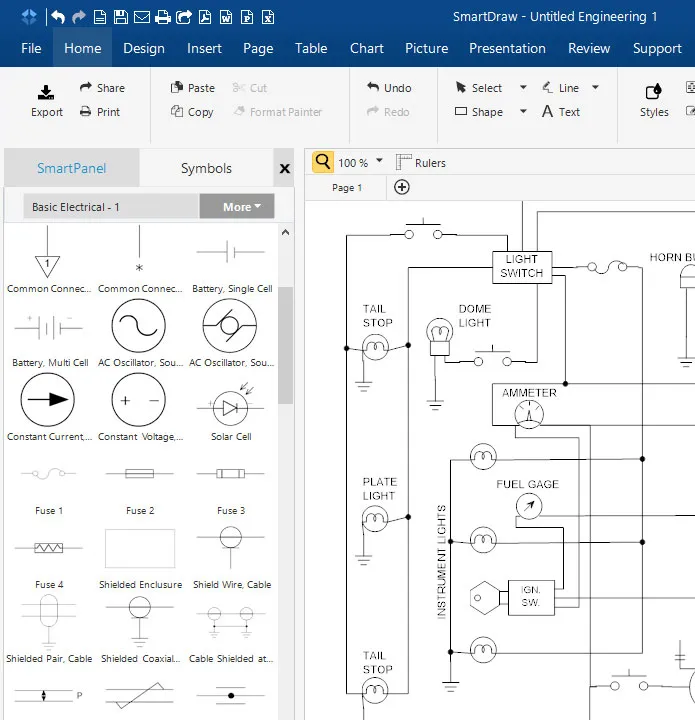
A ground symbol (IEC symbol 5017) identifies a ground terminal. It can be used for a zero potential reference point from where current is measured. It is also for electrical shock protection. There are a few different ground symbols. The one we're showing here is "Earth", but there's also a Chassis and Digital/Common ground with slight variations to this symbol.
Resistor
A resistor reduces current flow. In a schematic, this is represented with a few zig zag squiggles. We're showing the US/Japan version of this symbol (IEEE). The UK uses a simple box over a straight line (IEC). There are also symbols for variable and adjustable resistors as well as thermal and preset resistors.
Switch
Disconnects the current when open. We're showing a simple SPST (single-pole single-throw) toggle switch, but there are variations for SPDT, pushbutton, dip, relay, and more. For a complete list of switch symbols, check out SmartDraw's electrical symbol library.
Capacitor
A capacitor symbol shows two terminals running into plates. The curved plate indicates that the capacitor is polarized. The curved side has lower voltage. A small plus sign can be added to the straight side indicated the positive pin.
Fuse
A fuse protects electrical circuits by stopping the flow of current when the intensity of current exceed a set value. It does this by melting a special wire.
Antenna
Marks a device, rod, or wire designed to capture radio and electromagnetic waves into electrical signals and vice versa.
Inductor
An inductor is also called a coil or reactor. The coils store energy in a magnetic field or flux. An inductor symbol looks like a series of looped coils.
Transformer
A transformer is two or more coils coupled by magnetic induction. It helps keep the frequency and reduce tension in an AC circuit.
Motor
A motor is a device that can transform electric energy into mechanical energy.
Source
Represents the power source for your electronics. This symbol represent a direct current (DC). To represent AC current, you'd replace the plus and minus sign with a wave.
Battery
Batteries are represented on a schematic with a pair of disproportionate, parallel lines. The number of lines indicates the number of series cells in the battery.
Diode
A diode only allows current to flow in one direction. It's always polarized with an anode (A, positive) and cathode side (C, negative).
Diode LED
A diede LED is a standard diode symbol with two small arrows showing the emission of light.
Make Wiring and Circuit Diagrams
Making an electrical diagram is easy when you have thousands of electrical symbols at your fingertips.
SmartDraw lets you choose from an enormous library of professionally designed electrical symbols for block diagrams, circuit panels, wiring diagrams, and many other types of drawings.
SmartDraw is easy to use too. Just select a template and start customizing. Click and stamp electrical symbols onto your layout. Add connecting lines and arrows. Reposition them on the page and SmartDraw will keep them connected, automatically.